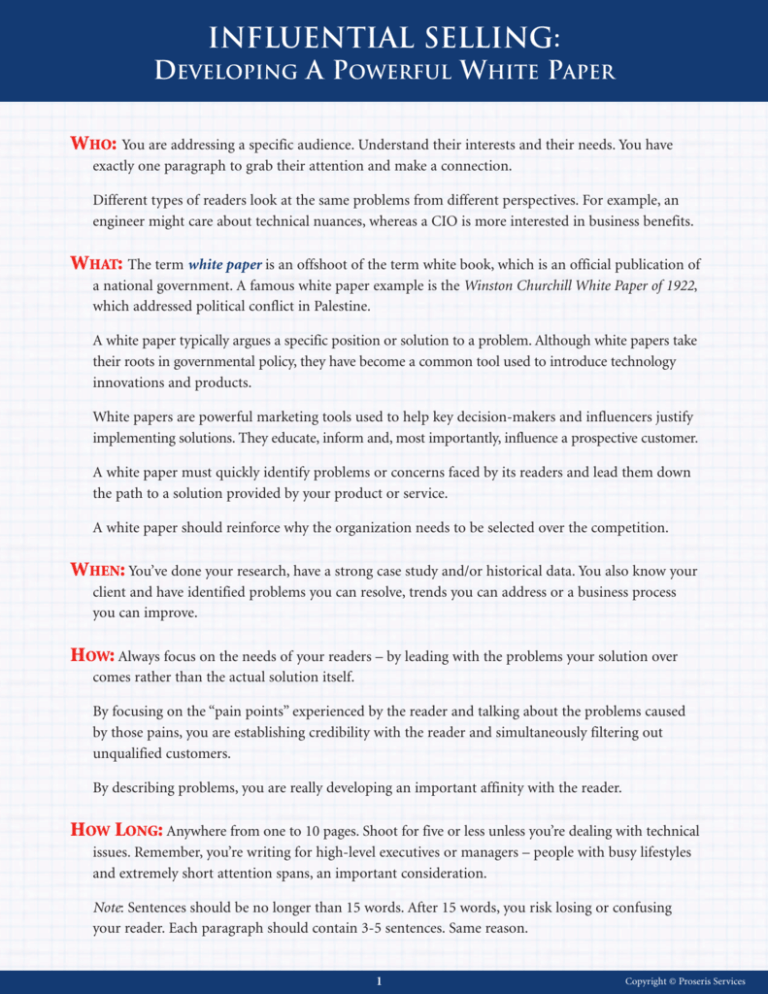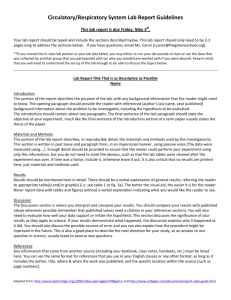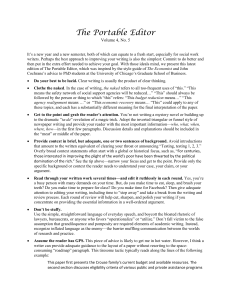Developing a Powerful White Paper
advertisement

Influential Selling: DEVELOPING A POWERFUL WHITE PAPER WHO: You are addressing a specific audience. Understand their interests and their needs. You have exactly one paragraph to grab their attention and make a connection. Different types of readers look at the same problems from different perspectives. For example, an engineer might care about technical nuances, whereas a CIO is more interested in business benefits. WHAT: The term white paper is an offshoot of the term white book, which is an official publication of a national government. A famous white paper example is the Winston Churchill White Paper of 1922, which addressed political conflict in Palestine. A white paper typically argues a specific position or solution to a problem. Although white papers take their roots in governmental policy, they have become a common tool used to introduce technology innovations and products. White papers are powerful marketing tools used to help key decision-makers and influencers justify implementing solutions. They educate, inform and, most importantly, influence a prospective customer. A white paper must quickly identify problems or concerns faced by its readers and lead them down the path to a solution provided by your product or service. A white paper should reinforce why the organization needs to be selected over the competition. WHEN: You’ve done your research, have a strong case study and/or historical data. You also know your client and have identified problems you can resolve, trends you can address or a business process you can improve. HOW: Always focus on the needs of your readers – by leading with the problems your solution over comes rather than the actual solution itself. By focusing on the “pain points” experienced by the reader and talking about the problems caused by those pains, you are establishing credibility with the reader and simultaneously filtering out unqualified customers. By describing problems, you are really developing an important affinity with the reader. HOW LONG: Anywhere from one to 10 pages. Shoot for five or less unless you’re dealing with technical issues. Remember, you’re writing for high-level executives or managers – people with busy lifestyles and extremely short attention spans, an important consideration. Note: Sentences should be no longer than 15 words. After 15 words, you risk losing or confusing your reader. Each paragraph should contain 3-5 sentences. Same reason. 1 Copyright © Proseris Services HOW TO START: Assume your reader is completely new to the subject matter. Then outline the most significant issues and progressively walk through the solution; begin with the larger issues first and sequentially move though the other points. Outline the topics you want to address, the most logical sequence for those topics and how you want your paper to flow. Use relevant background materials, such as industry research statistics and quotes only if they are powerful enough to reinforce your concept or approach. The opening section should highlight what specific problem you want to solve. Each paragraph should discuss only one idea. Don’t mix ideas in the same sentence or paragraph. Case studies often show how theory becomes reality … a valuable addition to any white paper. WHAT ELSE: You can take your white paper a step further by looking at issues such as historical precedence, describing new classes of solutions that address the problems and even identifying what to look for in a solution, while never once mentioning your product name or company (at least not yet). This approach will score major points with the reader and greatly increase the likelihood he or she will actually read the entire paper. Make the summary just as powerful as your first paragraph. Readers often read the summary first. Leave the reader with at least three bulleted salient issues. Be sure your white paper reflects your company’s high standards. Poor quality material will have the opposite effect of what you intended. Persistence is the key. Once you get it right, a well-written white paper pays for itself many times over in the long-term. WHITE PAPERS CONTAIN ALL OR SOME OF THE FOLLOWING: 1. Current industry problems/trends: Begin with a description of the broadest issues and trends in the industry that will introduce the reader to the topic. Then move on to discussing the specific attributes of the solution. 2. Technology: Description of the technology if necessary. 3. How the service offered or the new technology or business model works. 4. Benefits/application/ROI/case studies. 5. Visual appeal: Add graphics, charts and images to break the monotony of reading text and also tools to understand the topic better. 6. How to choose a solution/vendor if applicable. 7. Summary. 2 Copyright © Proseris Services WHITE PAPER DON’TS: 1. Technical acronyms and other difficult terminology. 2. Technical complexity. 3. White papers are not user’s manuals. WHITE PAPER TEMPLATE: Abstract: A one-paragraph summary of what the white paper is about. Don’t include solutions here. State the problem: Two or three paragraphs demonstrating your knowledge of client’s challenges and industry trends. Identify main objectives of the paper. Describe your product: Don’t get too technical. Describe best practices, ease of use and illustrate liberally. Tie your product back to the solution of the problem: Use case studies, expert testimonials. Include benefits and ROI. Summary: Conclude with confidence, credibility and bulleted points you want reader to remember. 3 Copyright © Proseris Services







